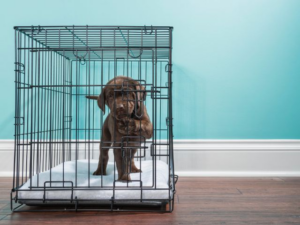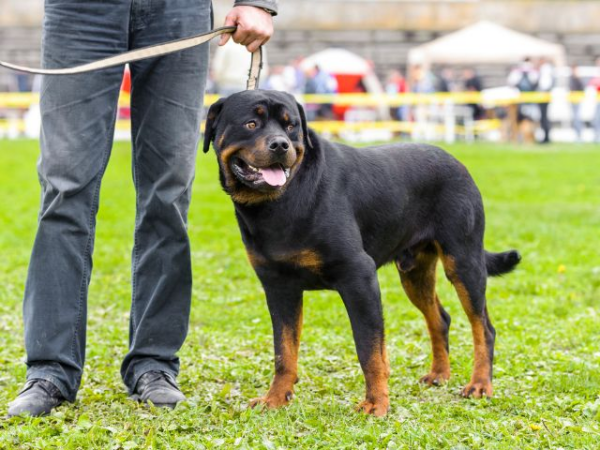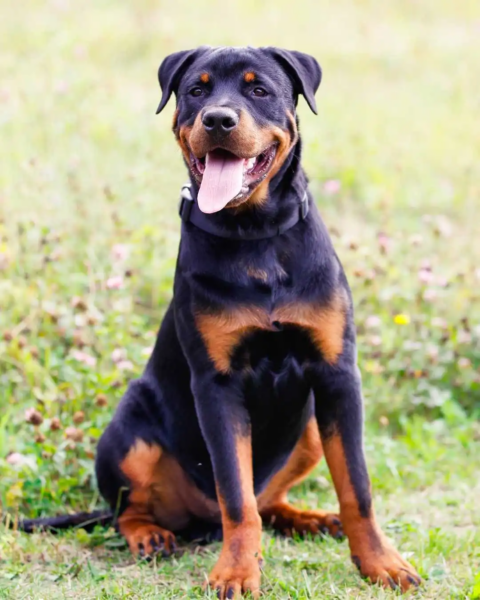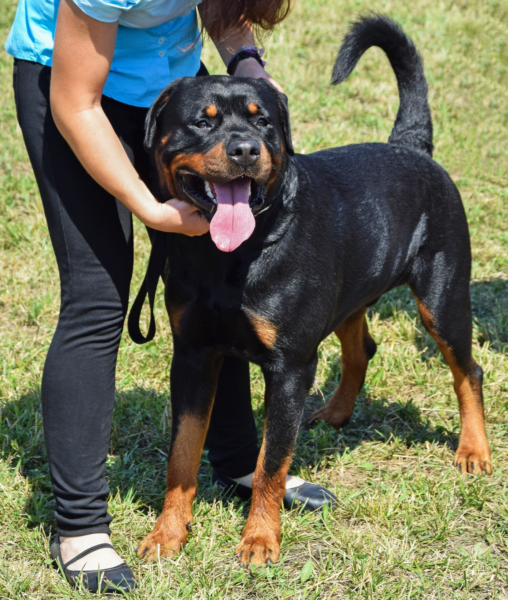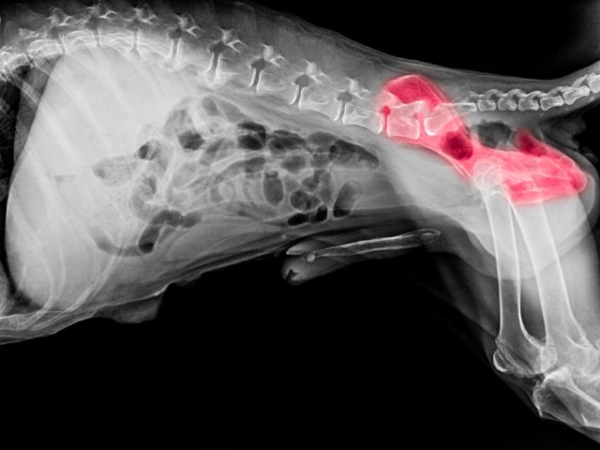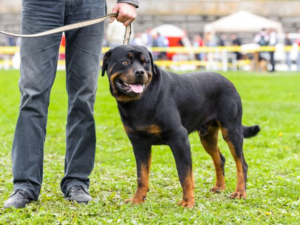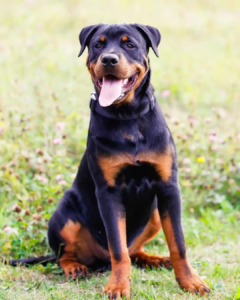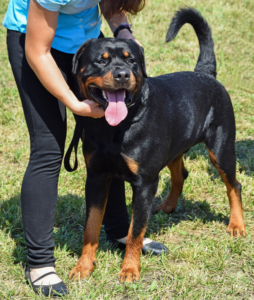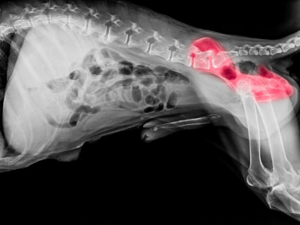In the context of dog training, a crate simply refers to a designated indoor or (less commonly these days) outdoor kennel or “box” in which a dog can be comfortably confined. The key word here is comfortable, and please note that this doesn’t only refer to the fact that the crate should be physically comfortable for your dog! It should also represent a comfortable mental place for your pet; a haven rather than a prison. Many adult dogs who were appropriately trained as puppies actively want to spend time in the crate when they need their own space!
Crate training a puppy involves gradually accustoming your dog to spending time confined inside the crate without this incarceration causing any distress. The process helps with housebreaking, as dogs are clean animals by nature and are less likely to eliminate within their confined “bed space”. It also serves as a useful tool when it comes to travel, behavior management and the alleviation of separation anxiety.
If you are interested in learning about clicker training, read here.
For more information on training your rottweiler at home, read here.
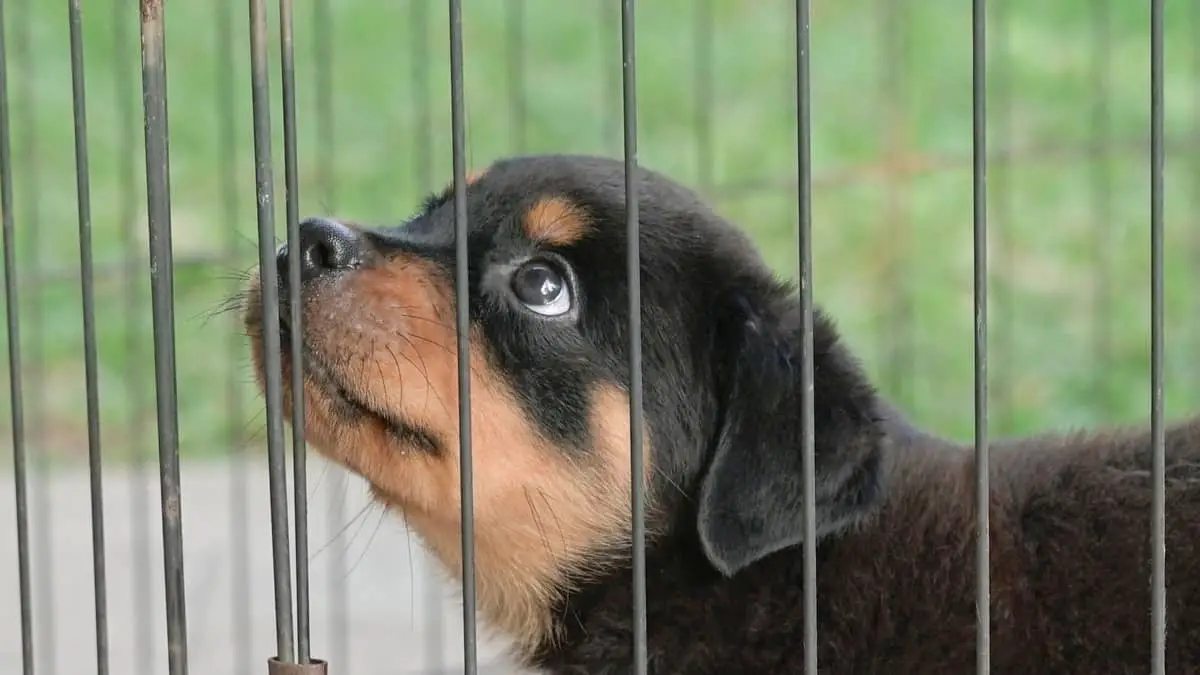
Why Should I Crate Train My Rottweiler Puppy?
As a veterinarian, I tell pet parents to think of the crate training process as an investment in their new puppy’s future; one that eventually pays off with both peace of mind for you, and a reassuringly safe space that your four-legged family member will ideally enjoy spending time throughout their life. It’s the canine key to a harmonious home and ultimately a well-adjusted adult Rottweiler.
A true game changer for new Rottie owners, crate training helps with potty training and will immediately result in fewer unexpected accidents, as well as less risk of furniture or other objects being chewed should you have to leave your new pet at home unattended (side note: this is also very important for your pup’s safety).
In addition to helping avoid chaos, this form of training allows you to create a physical and psychological haven for your pet, which will help stave off separation anxiety[1] as well as provide a retreat for your Rottie in the presence of a fear-inducing stimulus such as fireworks.
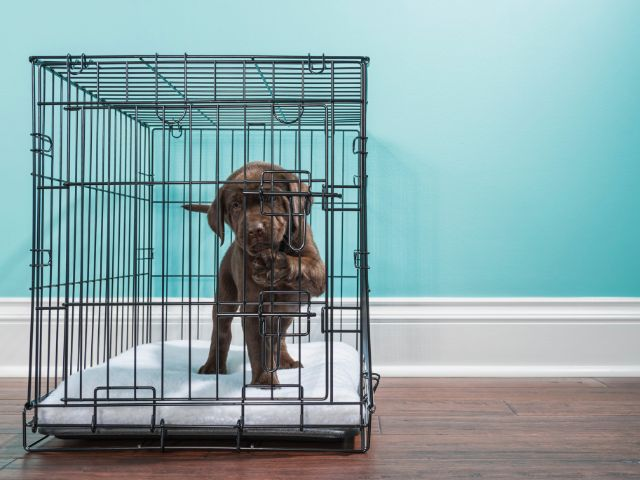
What to Look for in a Crate?
Key characteristics to look for in a crate are an appropriate size (more on this below) and an easy-clean, hygienic, and durable material (plastic or metal work well). Depending on your particular needs, you may also want to consider additional factors such as storage (eg, some wire crates are collapsible) or suitability for airline travel.
Top tip: flight kennels need to be approved by the airline you plan to fly with, so if you intend to travel with your Rottweiler it’s worth checking these requirements in advance of buying a crate.
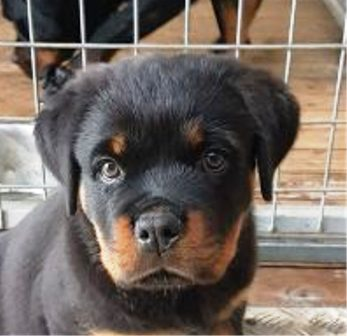
How Do You Know What is the Right Size Crate?
When it comes to picking the right crate for your Rottie pup, size matters! Crucially, you need to remember to account for the fact that your puppy will grow significantly from their current mini-Rott size to that of a full-grown adult Rottweiler weighing in at around 80-135lb (36-61kg)!
Pick a crate that is large enough to be a comfortable fit for your pet (when fully grown) to be able to stand up fully and turn in a circle, and block off excess space in the meantime to discourage your still-tiny pup from mentally allocating a toilet area within the crate whilst there’s still free real estate on the market.
Which Type of Crate is Best?
Whilst everybody’s unique needs and home will be different, personally (and professionally) I tend to prefer metal wire dog crates for large breed puppies such as Rottweilers, lined with surplus carpet material or “vet bed” material during the crate training process. I then suggest adding some additional soft bedding thrown in there for good measure. These beds are easy to clean and maintain, safe and hygienic for your pet, and can often be collapsed for easy transport and storage if required.
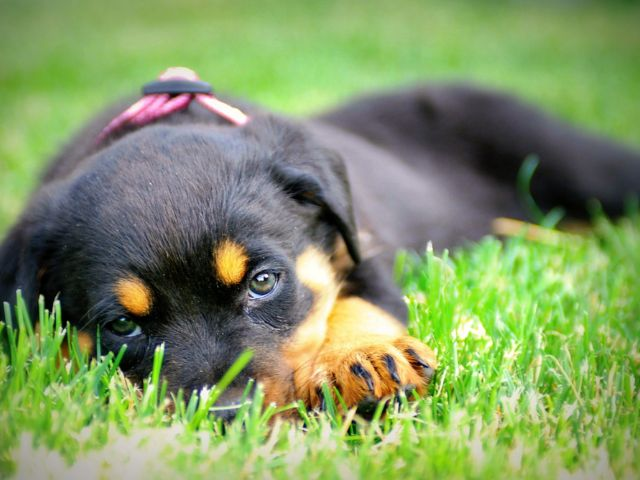
Crate Training a Puppy
The best time to introduce a crate is whilst your Rottweiler is still a puppy. The younger the better, as pups are most accepting of new experiences whilst they are between around 3 and 8 weeks of age. Of course, in most cases, a Rottie pup will still be with the breeder at this age, so in an ideal world I would advise that you discuss with the breeder in advance whether perhaps they can get the process started before you even bring your new dog home.
You’ll follow the training procedures outlined below for your puppy, and there’s a few bits you’ll need to gather before you get started:
- Small food treats (to use as rewards)
- A favorite toy (this will also be used as a reward)
- An appropriate crate
- Bedding
- Food bowl
- A little bit of patience!
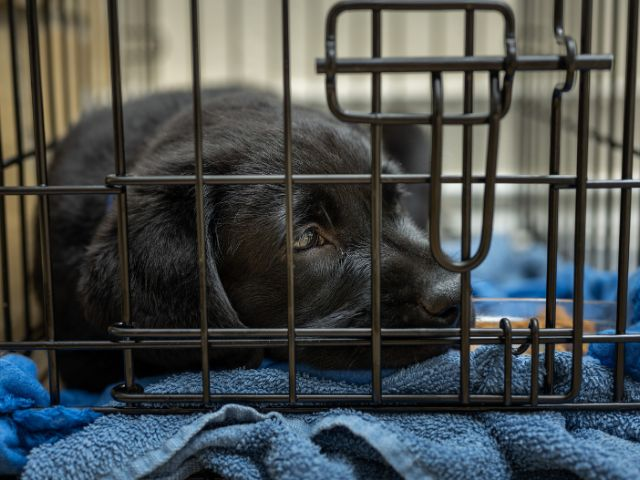
The Crate Training Process
The step-by-step guide below can be applied to all ages, from young pups through to older dogs. A puppy will adjust faster to the crate than an adult dog, but even elderly pets can be acclimatized to the crate with patience and consistency. Many owners find that the crate helps their dog with separation anxiety problems, and as a vet, I certainly recommend carefully introducing a crate if this is an issue.
Prepare the Crate
Select a spot for the crate where the family spends a good amount of time, such as the kitchen. If you have children, make sure it’s added to the house rules that when your Rottie is in the crate, nobody is to behave in a manner that encourages excitement or to hassle the dog. Remember that the crate is your dog’s safe space, where they are expected to be calm and relaxed.
Cozy bedding such as a soft blanket is a must for puppy crate training (well, except for those dogs who against all reason seem to prefer lying on a hard floor!) Even better if you want to donate an old T-shirt or dressing gown that smells of you for a comfort blanket. You can also add treats and toys for your pup to discover.
Positive Introduction
You should never force your puppy into the crate during the training process. Rather, use positive reinforcement: praise your puppy, or reward them with treats, a quick, fun game, or just a whole bunch of attention, each time they willingly enter the dog crate [2],[3]. Most puppies seem to value playtime with their owner just as highly as food, so this is a great way to reward your dog that won’t cause them to become overweight.
Mealtimes in the Crate
The next step is to start feeding your puppy their meals inside the dog crate. Place their food dish inside with the crate door open, and let your puppy get used to eating in there. Then, begin closing the crate door whilst they are eating, but be sure initially to open the dog crate before they have finished.
Once your puppy is comfortable with the above, you can start to gradually extend the time the door stays closed little by little. Avoid opening the dog’s crate door at the same instant that your little one is whining or exhibiting excited behavior; wait instead and open it when they are momentarily quiet.
Gradually Extend the Alone Time
Start to crate your puppy outside of meal times, providing alternative incentives such as treats and toys (Kongs are always a winner). Start by staying in the family room with your crated pup, then gradually begin to leave quietly, without making a fuss, and initially just for 15-30 seconds at a time. Increase the alone period gradually: every puppy learns at its own pace, but as a broad goal after several weeks of training a puppy, they should be happy being left alone in the crate for 4-6 hours at a time (including overnight).
How to Crate Train a Rottweiler Puppy at Night?
You should still follow the step-by-step guide above when it comes to nighttime training. By the time you reach step 4, your Rottie pup will be sleeping comfortably in his or her crate through the night. A key takeaway here is that you can’t go from zero to one hundred immediately: successful crate training takes time!
Again, it’s an investment in your dog’s future so it’s worth doing right. Please don’t just immediately leave your Rottie pup in a crate all night long and expect a great outcome. Whilst he or she will eventually give up on howling, it’s not a recipe for a well-adjusted pet.
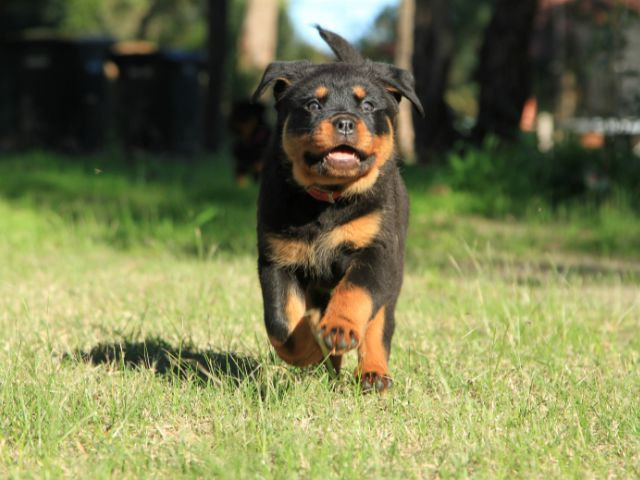
What is the First Thing to Teach a Rottweiler?
I make no apology whatsoever for getting a little deep in my answer to this question! The first thing you should teach a Rottweiler (whether they be a new puppy, or an adopted older dog) is that you are a consistent human being whom they can trust.
Honestly, before you attempt any targeted training with your brand new Rottie, spend a few days just getting acquainted with him or her first and building a working bond. It will do wonders for your ability to understand each other moving forward and open the channels of communication that will be vital for the training that is to come.
Are Rottweilers Hard to House Train?
Generally speaking, no.
Rottweilers are faster than many breeds when it comes to picking up new tricks. This is due to the breed’s historical background as working dogs, which of course meant they needed above-average intelligence as well as their awe-inspiring size and strength! So, whilst every individual dog is different, as a rule, Rotties are not a difficult breed to house train.
How Do You Discipline a Rottweiler?
This one is a trick question: the answer is, you shouldn’t!
Now, that doesn’t mean I’m saying you should let your Rottie run wild and cause chaos to his or her heart’s content – far from it. Where such large and powerful dogs are concerned your canine charge must be well-trained and well-behaved. But pet parents should aim to achieve this goal via positive training methods that are rewards-based, and never those that rely on punishment.
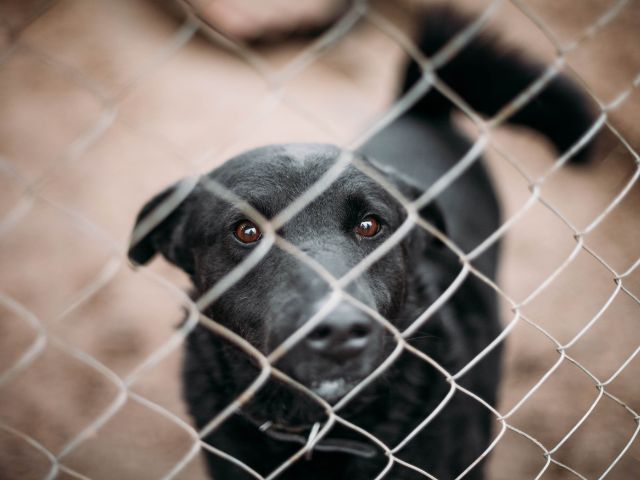
How Long Should a Rottweiler Be in a Crate?
As a general rule, once you have followed the step-by-step guide above under “How to Crate Train a Puppy” your Rottweiler will be able to spend 6-8 hours in their crate without experiencing distress or discomfort. Of course, before being confined for this length of time it is imperative that a long walk (doubling as a toilet break) is provided beforehand, and that your pet has access to water. The temperature in the dog’s crate should be a comfortable room temperature where your Rottie cannot overheat.
It’s important to take your dog’s age into account too. Be aware that young puppies may not be able to hold their bladder for a full 6-8 hours, and so even if your puppy is fully house-trained you’ll need to provide a potty break at least every 4 hours until your Rottweiler is 6-8 months old. At this age, most dogs will be able to comfortably wait through the night for a potty break first thing in the morning.
Of course, it goes without saying when you crate train your dog, 8 hours in the crate should be reserved for overnight or for unavoidable situations where crating is necessary, such as travel.
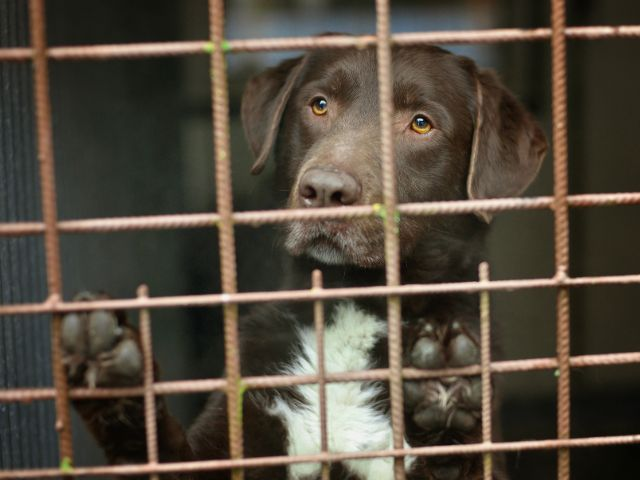
Should Rottweilers Be Crated?
Whilst the question of whether or not to crate a dog is often one of hot debate amongst dog owners, dog trainers, and the veterinary community, my own personal and professional opinion as a vet is that yes, crate training puppies is a great idea. So should puppies of every other breed, for that matter!
Not only does crate training help ensure you have the means to prevent your Rottie from causing havoc where required, but it is also truly valuable for your pet’s mental health and well-being, as we have discussed. This should not be overlooked!
What is the Best Training Method for a Rottweiler?
Training methods that rely on the use of positive reinforcement are commonly reported to be at least as effective (if not more so!) than methods that rely on punishment [4]. What’s more, reward-based methods are obviously infinitely more welfare-friendly and will not negatively affect your bond with your Rottie, or negatively impact their psychological wellbeing.
Whilst punishing a dog (what behaviorists term ‘aversive’ methods) is certainly likely to result in a reduced frequency of the undesirable behavior, it will also result in the development of a pet that is fearful, anxious or even aggressive: certainly not an outcome any Rottweiler owner wants. The bottom line? Stick to positive, rewards-based methods that aim to create a positive association. You’ll still achieve great results but without any downside.
References
- Owens, M. and Wetherell, J. (2024) ‘Crate Training Your Puppy’, UC Davis.
- Getz, P.B. (2021) ‘How to Crate Train a Rottweiler Puppy’, Wag!
- Sharpe, S. (2023) ‘How to Crate Train Your Dog in Nine Easy Steps’, American Kennel Club.
- Vieira de Castro, A.C., Araujo, A., Fonseca, A., Olsson, A.S. and Clegg, S. (2021) ‘Improving dog training methods: Efficacy and efficiency of reward and mixed training methods’, Plos One, 16(2).

